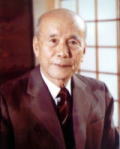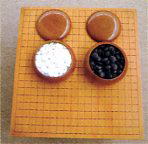Kaoru IwamotoHoninbo Kunwa



Kaoru Iwamoto(岩本薫 1902―1999) also known
as Hon-inbo Kunwa, was a Japanese professional “Go” player who achieved the rank
of 9-dan.
He was born in Masuda City of Shimane prefecture. He was a follower
of Heijiro Hirose, 8-dan. His strategy
of “Go” was called “mamemaki Go” (scattering beans Go) , because at first his
stones are scattered everywhere. Later those stones are used to pressure his
enemy bit by bit.
He happened to be playing “Go” in the outskirts of
He was the chief director of Nihon Ki-in and the director of Nihon
Ki-in Chuo Kaikan.
In his later years he was the main benefactor of several European and
American “Go” centers in
Biography of Kaoru Iwamoto
| Year | Age | Events |
| 1902 | On February 5, 1902, Kaoru Iwamoto was born
in Takatsu, |
|
| 1905 | 3 | Moved to |
| 1911 | 9 | Started to play Go with his father. |
| 1913 | 11 | Returned to |
| 1917 | 15 | Achieved 1-dan. |
| 1918 | 16 | Visited |
| 1919 | 17 | Achieved 2-dan. |
| 1920 | 18 | Achieved 3-dan. |
| 1922 | 20 | Achieved 4-dan. |
| 1923 | 21 | Visited |
| 1924 | 22 | Became a member of the Nihon-kiin which was established this year. |
| 1925 | 23 | Achieved 5-dan. |
| 1926 | 24 | Achieved 6-dan and visited
|
| 1927 | 25 | Married Karasawa Kikue. |
| 1929 | 27 | Emigrated to |
| 1931 | 29 | Came back to |
| 1935 | 33 | Elected as one of the top committee members of the Nihon Ki-in. He won
the Oteai, one of the most important tournaments in |
| 1941 | 39 | Achieved 7-dan, and became a permanent director of the Kido-hokokukai.(棋道報国会) |
| 1945 | 43 | Became a permanent director of the Nihon Ki-in.
Due to the Nihon Ki-in’s office was burnt down by a bomb during the war, Iwamoto’s house turned into the temporary office of the Nihon Ki-in. Challenged the third Hon-inbo match held in |
| 1946 | 44 | The third Hon-inbo match was resumed after the war. He won two games and received the Hon-inbo title. He was called as Hon-inbo Kunwa. |
| 1947 | 45 | Defended the Hon-inbo title against Kitani Minoru at the forth Hon-inbo match. |
| 1948 | 46 | Achieved 8-dan and became the president of Nihon Ki-in.(~1949) |
| 1950 | 48 | Lost the Hon-inbo title, gave to Hashimoto Utaro. |
| 1952 | 50 | Won the All Hon-inbo & All 8-dan holders match. The last cmpetitor was Kitani Minoru. |
| 1954 | 52 | Became the first director of the Nihon Ki-in Chuo Kaikan(Nihon Ki-in central hall) |
| 1955 | 53 | Won the second NHK Cup. |
| 1959 | 57 | Stayed in US for the 14th
Hon-inbo league much in |
| 1961 | 59 | Stayed in US for a year to make the game of Go popular. |
| 1962 | 60 | Visited |
| 1967 | 65 | Achieved 9-dan. He visited North and |
| 1970 | 68 | Visited South America and |
| 1972 | 70 | Visited South America and |
| 1973 | 71 | Given the medal of Kun-Santo Shiju Housho. |
| 1974 | 72 | Became the vice chief director of Nihon Ki-in. |
| 1975 | 73 | Visited |
| 1978 | 76 | His pupil, James Kerwin, achieved Sho-dan(1-dan). He is the first professional Go player among westerners. |
| 1983 | 81 | Retired in April. |
| 1987 | 86 | Established the Iwamoto Foundation with the initial contribution of 530
million yen and became an honorary citizen of |
| 1989 | 97 | Was the main benefactor of the Go Center in |
THE IWAMOTO NORTH AMERICA FOUNDATION for GO http://www.inaf-go.org/